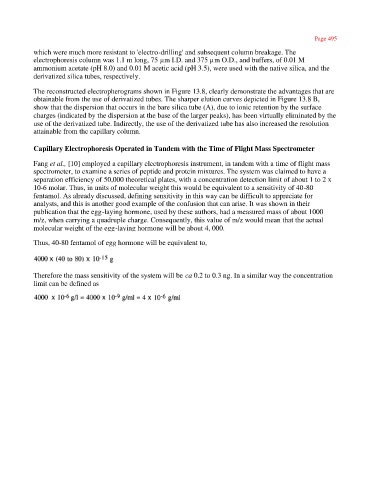Page 509 - Tandem Techniques
P. 509
Page 495
which were much more resistant to 'electro-drilling' and subsequent column breakage. The
electrophoresis column was 1.1 m long, 75 µm I.D. and 375 µm O.D., and buffers, of 0.01 M
ammonium acetate (pH 8.0) and 0.01 M acetic acid (pH 3.5), were used with the native silica, and the
derivatized silica tubes, respectively.
The reconstructed electropherograms shown in Figure 13.8, clearly demonstrate the advantages that are
obtainable from the use of derivatized tubes. The sharper elution curves depicted in Figure 13.8 B,
show that the dispersion that occurs in the bare silica tube (A), due to ionic retention by the surface
charges (indicated by the dispersion at the base of the larger peaks), has been virtually eliminated by the
use of the derivatized tube. Indirectly, the use of the derivatized tube has also increased the resolution
attainable from the capillary column.
Capillary Electrophoresis Operated in Tandem with the Time of Flight Mass Spectrometer
Fang et al., [10] employed a capillary electrophoresis instrument, in tandem with a time of flight mass
spectrometer, to examine a series of peptide and protein mixtures. The system was claimed to have a
separation efficiency of 50,000 theoretical plates, with a concentration detection limit of about 1 to 2 x
10-6 molar. Thus, in units of molecular weight this would be equivalent to a sensitivity of 40-80
fentamol. As already discussed, defining sensitivity in this way can be difficult to appreciate for
analysts, and this is another good example of the confusion that can arise. It was shown in their
publication that the egg-laying hormone, used by these authors, had a measured mass of about 1000
m/z, when carrying a quadruple charge. Consequently, this value of m/z would mean that the actual
molecular weight of the egg-laying hormone will be about 4, 000.
Thus, 40-80 fentamol of egg hormone will be equivalent to,
Therefore the mass sensitivity of the system will be ca 0.2 to 0.3 ng. In a similar way the concentration
limit can be defined as

